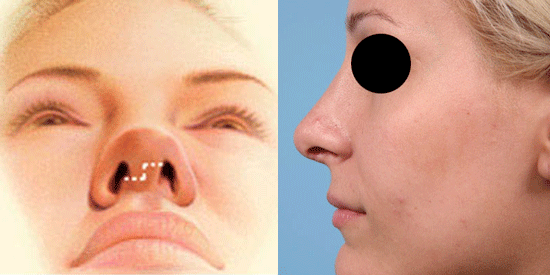Patients interested in rhinoplasty in Chicago may have come across the terms “open” and “closed” when reading about the procedure. Even though the choice of a rhinoplasty technique depends mostly on the patients’ goals and the surgeon’s preference, I prefer performing open rhinoplasties on most of my patients. I’ll explain why in this blog post.
What is an open rhinoplasty?
An open rhinoplasty is performed by creating a small incision on the underside of the nose between the nostrils in somewhat of a Z-shaped pattern. In a closed rhinoplasty, the only incisions are made on the inside of the nose, through the nostrils. The skin on the outside of the nose is unaffected.
The main disadvantage of closed rhinoplasty is it limits what the surgeon can do. With limited visibility of the tissue, bone, and cartilage, it is more difficult to discern which tissue needs to be altered and how much it should be changed. Additionally, incisions made on the inside of the nose weaken the structure of the nose, compromising the integrity of the nose shape and form in the future.
What are the advantages of an open approach?
There are 2 main advantages to an open rhinoplasty.
- Visibility of internal tissue: The greatest advantage of performing an open rhinoplasty that the surgeon has is the accessibility to the anatomy of the nose below the skin’s surface. That allows for more precise, accurate changes to be made to the shape of the nose. I can modify structures rather than simply remove them. Many patients have underlying asymmetry to their cartilages which can only be visualized through an open approach.
- Improved preservation of structural support: As alluded to above, many times the shape of the underlying cartilages can be modified with sutures, small feathering incisions in the cartilage, and when necessary precise placement of cartilage grafts. This results in increased cartilage preservation and structural support.
What are the disadvantages?
There are few disadvantages to open rhinoplasty. Mainly, patients will have a minor incision on the underside of their nose in the crease between their nostrils. However, this incision will be closed with careful attention to the placement of sutures, for a smooth result that will be hardly noticeable. I have performed over 1,000 rhinoplasties but have only made minor revisions to this scar on a few occasions. It heals well in patients of all ethnicities, and with proper care, it will fade quickly.
For an example of open rhinoplasty, take a look at the patient pictured below. In the “after” image, you can see that the scar from the incision is barely visible.
Some surgeons have criticized the open technique because of prolonged swelling due to the elevation of the skin, and longer time in surgery. After years of experience and precise dissection, I can assure that in my hands this surgery does not take longer and is actually faster due to the improved visualization.
How is my approach unique?
While many other surgeons perform open rhinoplasties, I pride myself on being able to control the shape of the nose tip while still creating a natural look. A natural result is subtle, yet meets the patient’s goals. Other people may recognize that something slight has changed about the patient’s appearance, but they will not easily recognize exactly what that change is.
In addition to reduced downtime, my patients have very minimal bruising after their surgery, which will likely be resolved or easily hidden with makeup within 7 days or less. Patients can return to work in 1 week without others being able to tell they have had surgery. Within 6 weeks, 90% of the swelling is gone and most patients are very happy with their nose by that time. However, it is important to note that minor swelling can take up to a year or more to completely resolve.
Earlier in my career, I performed exclusively closed rhinoplasties and have gradually evolved to the open technique. In the last 2 decades, over 95% of my rhinoplasties have been open. I reserve closed rhinoplasties for patients who have a dorsal hump but do not need any changes to their nasal tip.
You may find it helpful to view some of the before-and-after images from the rhinoplasty procedures I’ve performed in my photo gallery. I encourage you to look closely at the skin beneath the nostrils on these patients and note the limited visibility of the open rhinoplasty scar.
Contact us using the online form to request a consultation or call our office at (312) 788-2560 to schedule an appointment.




Leave a Reply